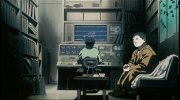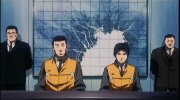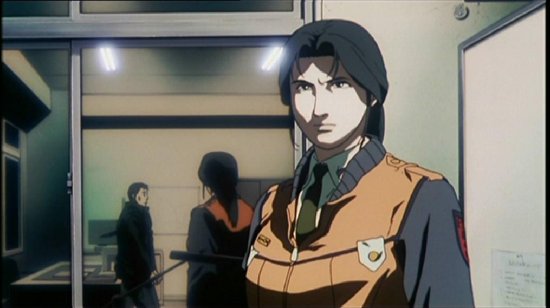Patlabor 2 The Movie: Limited Collector's Edition
Introduction
Seeing as I have already reviewed Patlabor The Movie, it would be remiss of me not to tackle the sequel as well, especially as I got both of the Collector's Editions in one handy twin-pack set. Patlabor is a mecha story, but one unlike the usual 'teenagers piloting giant robots against impossible odds' tales. Patlabor is far more down to earth, with the robots truly seen as machines rather than characters, and better off considered as two legged tanks, or forklifts. Patlabor proved to be quite a lucrative franchise for Mamoru Oshii, much in the same vein as Ghost In The Shell. The initial OVA series, spun off two feature films, a lengthy television series, another OVA, and most recently a third feature, one that has yet to be released in the UK. In fact, typical as always, we have only seen the first two feature films in the UK, first courtesy of Manga Entertainment, and then these Beez Entertainment re-releases. Just like the first film, Patlabor 2 was revisited to bring it up to scratch for the 21st Century, with a cleaned up, remastered print from an HD source, as well as 5.1 audio in both English and Japanese, although the heroic efforts applied to Patlabor weren't required here. Once again, the first Manga Entertainment dub has been ditched in favour of a new English dub from Bandai.
You're probably wondering why I'm reviewing the Patlabor 2 Limited Collector's Edition now, two years after it was released in the UK. In a slightly disheartening reflection of the genuine state of the UK anime industry, even a limited run of 1000 shiny exclusive packages still haven't found homes as yet. Believe it or not, you can still find these sets for sale online, and at a laughable fraction of the recommended retail price.
Back in 1999, a UN mission to South East Asia ended tragically when a Labor unit wandered into an ambush. There was only one survivor. Three years later in Tokyo, the Babylon project has been completed successfully, and now the population of Labors is being spread across Japan, bringing their powerful energies to construction projects all over the nation. Since Labor crime in Tokyo has fallen with the number of Labors, the 2nd Unit has effectively disbanded in all but name, with its members now all pursuing their separate career paths. Nagumo has been promoted to Commander, and as well as creating friction with her old commander Gotoh, she's also in charge of disseminating Labor policing techniques to all the new Patlabor Units being created in Japan.
However, all that is about to change when her past comes back to haunt her. When an explosion damages the Yokohama Bay Bridge, it seems like a terrorist action, until it becomes clear that it was actually a missile attack, and amateur camera footage indicates a JASDF F-16 in the vicinity. It's only the first in a wave of attacks, all of them targeted at the city, and all of them implicating the Japanese Self Defense Forces. As the government continues to back-pedal and obfuscate, a member of the SDF approaches Gotoh and Nagumo with evidence that appears to implicate a man named Tsuge Yukihito. Tsuge was once Nagumo's instructor, and their relationship developed beyond the professional. He was also that sole survivor of the ambush in South East Asia. Now it appears that he wishes to bring that war to the capital, and as the mayhem escalates and the city spirals towards martial law, he may just get his wish. This time, not only must the 2nd Unit save the city from terrorism, they'll have to save it from its own government as well.
Picture
Patlabor 2 gets a 1.85:1 anamorphic transfer. It's a standards conversion again, but a really quite good one. Ghosting, judder, and softness are all absent. You'll have to pause the disc, and probably skip forward a few frames before you spot the interlacing. It's on a par with the first film in that respect. However, made three years after Patlabor, Patlabor 2 is a wholly different animal, a generation away in terms of animation quality, level of detail, and complexity. It's also visually much more arresting, with striking and atmospheric visuals, and a much more coherent approach to the story telling. Whereas in the first film, an extended sojourn around Tokyo felt like directorial indulgence, here, you can see the point in the director's vision, and at no time do you feel that any frame is wasted.
Just like the first film, the image is clear and sharp, and absent any significant print damage. The filmmakers opted for a soft, autumnal palette, and the colours are very realistic. Two nitpicks this time, with that artefact of cel animation, the jumpy frame in evidence more than once in the film. And once again the black levels just aren't good enough at times, and consequently darker scenes lack definition, while the greys and blacks seem to blend into each other.
Sound
You have a choice between DD 5.1 English and Japanese, with optional English subtitles, and this time a signs only track. The surround is very effective, bringing across the action well, while Kenji Kawai's music is shown off at its best. I also felt this time that his score had more of a hook to it. I didn't see the original version, but I have experienced enough Manga Video dubs in my life to be profoundly grateful for the new Bandai dub, which is well cast and well performed (judging from the few minutes I sampled at least). My preference as always is for the Japanese version, and I found it to suit my usual expectations. I wasn't fond of the subtitle font used though, which looked a little too rough at the edges for my taste.
Extras
The Limited Collector's Edition is a brick of a boxset. I bought the Patlabor 1 and 2 twin set, so that's two bricks in one hefty package. Patlabor 2 the Movie is packaged in a hefty gold cardboard construction, bestrewn with Honneamise and Bandai logos, with some really splendid artwork to ogle. A label that regionalises the set to the UK covers the backside and bottom, and it's here where you'll find the Beez logo, the BBFC rating, and the Region 2 mark. This is peel-off-able, as is another BBFC sticker at the front. There is another label at the top that tells you just which of the 1000 sets you have. Yes, it's identical to the Patlabor 1 packaging, in all but hue.
Inside the case, you'll find your DVDs and two books.
The 300-ish page book of storyboards is just that. It's nicely covered in sturdy, gold, embossed card, and inside you'll find the whole movie in storyboard form, annotated in English (probably translated from the Japanese), giving you an idea of just what the director intended. There's a glossary at the back to help you decipher the filmmakers' jargon, as well as a proviso that most of the jargon is out of date, following the switch from cel to computer animation.
Patlabor 2: The Movie Archives is a 140-ish page book that is the real delight of this set. Everything you want to know about this film, from the production, the concept, the story, is all examined here. There are interviews with the director, and the composer. There's input from many of the players behind the film, including the voice cast. There's a look at the location photography, the concept art and there's much, much more for you to take in, as I've really just scratched the surface. The cover art is quite special, and the book is filled with stills, diagrams, photos and concept art in black and white, and colour.
The discs are contained in a card-bound book style package, although the discs are held in two digipack inserts, glued to the card. The two inserts also click together, stopping the book from falling open.
Disc 1 contains the film, as well as the teaser and theatrical trailers, as well as four TV spots.
Disc 2 is exclusive to this Collector's Edition, and contains the 1994 Making of Patlabor 2 Documentary. It's 42 minutes in length, although divided into easily accessible chapters, and offers insight into the location scouting, the story, the animation and the design, the sound and music, and much more besides.
Conclusion
That's more like it. Having watched the first Patlabor film, I certainly appreciated it for its visuals, and the scope of what it was attempting to accomplish. However, the execution was flawed, with a film that meandered into self-indulgence, and characters that, while they may have been familiar from the OVAs, stood somewhat at odds with the overall tone of the film. The comedy seemed out of place with the sombre view of the story. Not so with the sequel, which is a grand improvement over the first film. Patlabor 2 has a better, more fully formed story, is much more of a piece, with nothing seeming out of place; even what in the previous film may have been considered indulgences on the director's part, are integral to the story here. The comedy is gone altogether, there's very little goofiness or overreaction from the characters, perhaps something accomplished by moving the story 3 years ahead in time.
The story is also much more compelling, which while it once again takes a look at terrorism, does so in a more rounded and developed a manner, very much with politics at the heart of it. Whereas the antagonist of the first film was somewhat vague in motivation, difficult to fathom, the antagonist here has motives that are easier for the audience to relate to. Also, this is a far more human and personal film. The Patlabors are notable by their absence, remaining so for the duration of the film, and only really making a contribution to the climax. Patlabor 2 is really all about the characters, and unlike Noa and Asumi, this film centres on their commanding officers, Nagumo and Gotoh. Noa and Asumi have moved on in the three intervening years though, and Noa has lost her infatuation with Labors, but by concentrating on their commanders, Patlabor 2 underlines the fact that this is a more mature film, grown up in every respect.
Gotoh and Nagumo's relationship certainly strays beyond the professional, and you'd be hard pressed to take them as anything other than a married couple, with the familiarity they have with each other. Tsuge becomes the third point of that triangle, he's Nagumo's former instructor, with who she had a relationship that most likely resulted in her back of beyond, 2nd Unit posting, and now he's back, suspected of the terrorist attacks. His return certainly causes her life complications, and she's soon conflicted between her former lover and her current loyalties. It doesn't help when the government appears to turn on its own police forces and military. Gotoh's left trying to help her and keep her out of trouble, without letting their superiors know, and even without letting her know.
Patlabor 2 also excels in the big picture, painting a plausible scenario in which a democracy can spiral into despotism, playing on the tension that exists between a democratically elected government, and the military that is supposed to serve it. It takes one man who understands that tension, who knows where to nudge, and who knows how to manipulate the system, to turn the tension into outright mistrust. You think that the end result is absolutely ridiculous, that a government simply cannot turn on its own authorities, but the way Patlabor 2 unfolds is so logical and considered, albeit with an occasional jolt from a plot device or two, that it becomes very believable. In fact Patlabor 2 caused quite a controversy in Japan, with the Sarin attacks happening not long after its release, and critics began drawing parallels with a scene in the movie.
In every respect, Patlabor 2 is the better film. The animation is crisper, the music is grander, the story is gripping, the direction is spot on, and the characters are much more engaging. If Patlabor is a film to own for the place it has in the history of anime, Patlabor 2 is a film to own because it is just a damned fine movie. Make a whole lot of room on your shelf for this boxset. The Patlabor Limited Collector's Edition, and Patlabor 2 Limited Collector's Edition are also available in a twin pack, which is how I got mine.









































































Your Opinions and Comments
Be the first to post a comment!